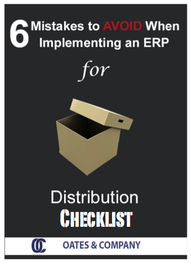Enterprise resource planning (ERP) is a type of business management software that supports the basic internal processes of a company. ERP software allows a business to have an integrated, real-time view of production, order processing, and inventory management. Product planning, development, customer and vendor data, materials management, sales, and marketing are also examples of what an ERP system can control and streamline.

Choosing to implement an ERP, however, is not always an easy undertaking.
Here are six common mistakes to avoid when doing so:
1. Failing to research and understand the ERP company you chose.
The job of the vendor’s marketing team is to sell you their product whether or not they know anything about your company. Some ERP companies – and there are many – are more suitable to large corporations versus small businesses and vice versa, and you should have a general knowledge of a company before you consider them for your needs.
2. Underestimating the need to have all employees “buy into” the product.
Implementing an ERP system is more than an IT project – it will affect every employee at your company. You need to make sure your employees are prepared and on board for the change; if they are unhappy or feel resentful about it, your implementation could fail.
3. Not understanding the amount of preparation necessary.
Any system you choose can only be as good as the data you provide for it. Every single process that is going to be replaced by the ERP system needs to be documented from beginning to end. Most importantly, this documentation should start as soon as the project receives the official “go ahead.” Do not wait until just before the system launches.
4. Not including the right people on the implementation team.
The ERP support people, management, and IT employees are the obvious team members, but don’t forget representatives from across the rest of your organization: finance, operations, manufacturing, purchasing, the warehouse employees, etc. These people are called the “key users” because they use the system every day to do their jobs. They will have important insights and should be on the team from the beginning.
5. Not testing real data.
Why are you implementing an ERP system? For better inventory control? For a more organized way of keeping track of your customer and vendor data? For all of the above reasons? Whatever the case may be, the only way to accurately test a new system is to run several days of the company’s real transactions through the system. Don’t invent fake customers and vendors or create fake inventory – real data, being used by real users, is the only way to see the real-world effects of the changes that will happen when the ERP implementation is complete.
6. Believing that the Go Live is the end of the process.
Even after the system launches and becomes official, you and your employees will need continued training and support to keep the ERP – and therefore, your company – running successfully.
Contact Oates & Company today and let us help you with your ERP implementation.



